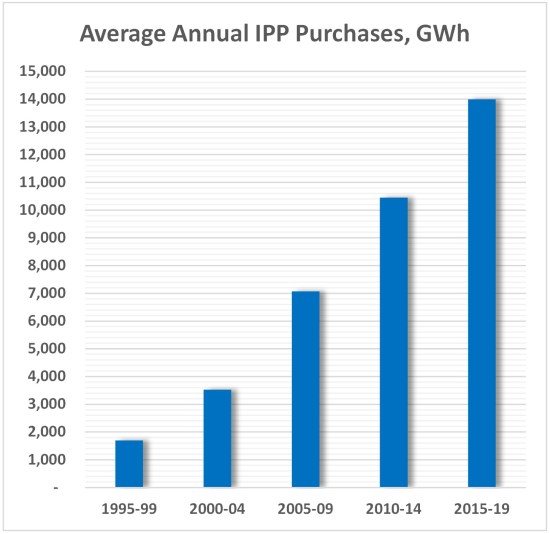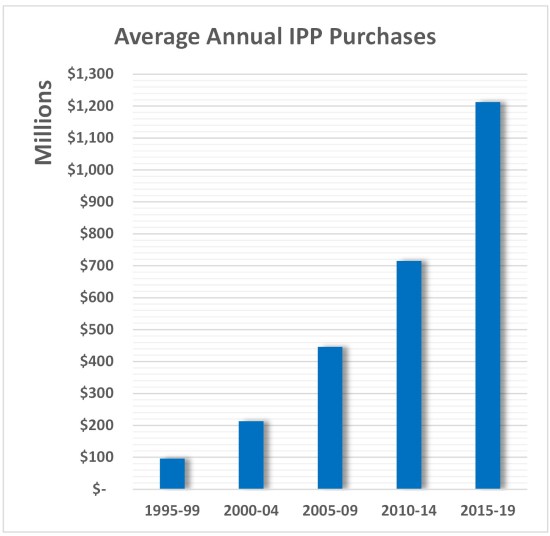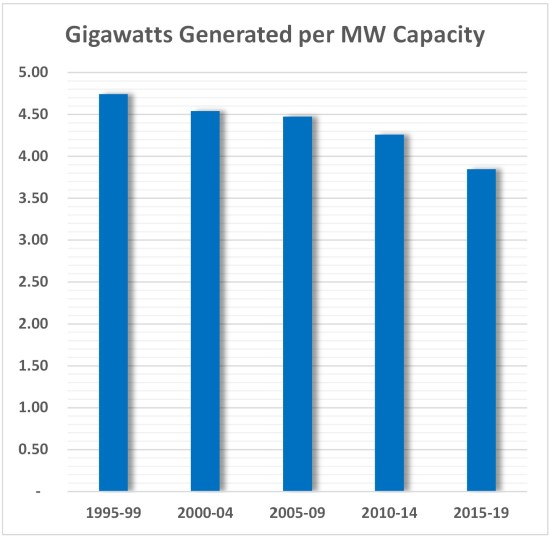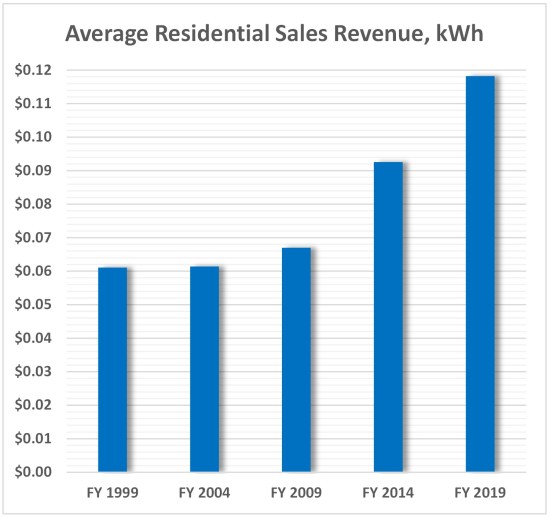In the preceding article, I suggested BC Hydro was a sinking ship, ineptly managed. Numbers taken from 25 years of annual reports provide much of the evidence.
Like other electrical utilities in North America, BC’s public utility experienced steady demand growth until about 2005. For decades, system planners believed a growing population would always need more electricity.
Deindustrialization, improved efficiency of electrical equipment and consumers’ conservation and self-generation dictated new thinking was needed. But large organizations don’t readily alter precepts.

Because the utility expected new demand, it was adding capacity to its own generators.

Additionally, by Liberal direction, BC Hydro was signing new contracts with independent power producers (IPPs).

These contracts provided for IPPs to be paid higher prices each year. The payouts were huge.

Mistakes compounded. The utility had too much electricity, too little domestic demand and export markets that offered a fraction of its marginal cost of power.
Since long-term IPP deals had been mandated by Liberal politicians with aversions to public enterprises, the arrangements were a reality unconnected to BC Hydro’s market conditions.
The easy solution to surplus electricity was to lower production at BC Hydro’s own facilities.

The financial consequences of unsound energy policies have impacts, particularly for residential consumers.

But those effects are not yet fully apparent. In 2019, BC Hydro is losing over $100 million a month on operations and spending even more on Site C and other unjustifiable capital projects. Losses are concealed by the continuing use of deferral accounts and million dollar public relations campaigns but those are not solutions.
At BC Hydro, the financial picture is deteriorating and most politicians and corporate media pundits avoid the subject.
Categories: BC Hydro




Hi Norm
It was interesting to read this article I can absolutely relate to your last sentence about “politicians and corporate media pundits avoiding the subject”. Our old operation has had an extremely difficult time finding media players that are willing to tackle BC Hydro, something that really needs to be exposed. Also I thought it was deplorably hard to communicate with Liberal politicians regarding electricity policy. Sadly I am finding it even worse with the current NDP Minister of Energy and staff. Sarah Cox of the Narwhal is the first one who was willing to draw attention to our sad story. Here is the link to the article for your interest in case you have not seen it.
https://thenarwhal.ca/bc-hydro-lacks-an-appetite-for-green-electricity-thats-hurting-this-historic-family-run-plant/
Happy to discuss what I know at anytime.
Hal Wright
Sandon, BC
LikeLike
Page 136 Table A17 of the 2019 BC Budget shows BC Hydro debt growing from $14 billion in 2012 to est. $23 billion in 2019. Would that include Site C?
Click to access 2019_budget_and_fiscal_plan.pdf
Annual debt growth over that time is 6.9% per year, meaning BC Hydro’s debt would double in 10 years at that rate going into the future.
LikeLike
Norm, how does Powerex figure into all of this?
I just read the following and admit I’m confused.
https://thenarwhal.ca/clean-b-c-is-quietly-using-coal-and-gas-power-from-out-of-province-heres-why/?fbclid=IwAR2Qgx_1KhhNV071LUl8borYrMbh7uo4A-bPJ6xnR97TzUtGmBJKJQjQc7w
LikeLike
In reporting electricity sales by BC Hydro, I routinely use the numbers for residential, commercial and light industry, and heavy industry. It is domestic demand that ought to set the province’s need for electricity. We should not be borrowing billions to meet some other jurisdiction’s power needs.
Export sales in these times may seem profitable but it is easy to argue most are not. Consider BC Hydro’s incremental cost of new power (marginal cost). That is established by purchases from IPPs and the average price paid in the most recent quarterly report was 9¢/kWh. (Even that is low because it is distorted by old agreements like Kemano.)
BC Hydro reported that trade sales realized 3¢/kWh.
The utility has low cost power from heritage facilities built decades ago. It has relatively high cost power from IPPs. If export sales of surplus power were evaluated by using marginal costs, they would be money losers.
Of course, some of Powerex’s trading is to bring in and use foreign power (much of it created by burning fossil fuels) when it is cheap on the spot market, and sell our clean hydro electricity into the spot market when prices rise.
Remember that Liberal politicians prohibited use of the publicly owned Burrard Thermal generators because they burn natural gas but ignored importation of electricity generated by coal and gas in AB and USA.
LikeLike
Thanks for that Norm.
LikeLike
Site C only confirms that the NDP do not care for future generations, rather they, like the Liberals are in power to reward political friends and in the NDP’s case, the unions.
Horgan a great chance to do things differently, but no he is nothing more than Liberal Lite, rewarding political friends and insiders at the expense of the province.
it is a sad, sad epitaph for the “Party of the People”.
LikeLike
And as food prices climb and crops fail due to climate shift issues, the potential to (have) use(d) the Site C lands for food will become more apparent every day.
LikeLike